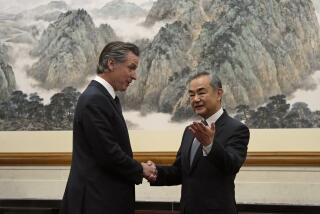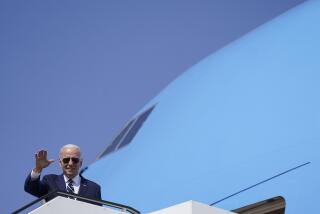PACIFIC RIM TRADE : Asian Dynamism Fills an Ocean of Commerce
- Share via
WASHINGTON — They steam out of West Coast ports every day, an average of 26 ships carrying 3,000 tons of cargo each, from tiny computer chips to gigantic earthmovers for buyers in China, Japan and other nations of the vast East Asian market.
On their return trips to America, the ships are laden with 5,000 tons each of cheap Chinese clothing, top-of-the-line Japanese computers and a bounty of consumer goods in between. The imbalance in tonnage reflects the stubborn U.S. trade deficit with Asia.
The Pacific Ocean and the sky above it have become the modern equivalent of the storied Silk Road, the overland route from the Orient to Europe that carried East-West trade in ancient times. As early as the 2nd Century BC, Romans were wearing garments made of Chinese silk, and the Chinese were burning oil in lamps imported from Rome. Camels carried the freight.
Now the routes of commerce are infinitely more complex. “When traced on a map, a vast network of air and ocean shipping routes, supported by threadlike communication links, forms a cat’s cradle of Pacific Basin interconnections,” says Mark Borthwick, American executive director of the Pacific Economic Cooperation Council, a 21-nation organization based in Singapore.
The U.S.-Japan link is the principal transpacific route, but just one of many. Of every $10 worth of U.S. trade with the Orient, Japan accounts for $4. China, looming as an economic giant, now accounts for $1 in every $10 of U.S.-Asian commerce, and its trade with the United States has doubled in just three years. Taiwan, South Korea, Singapore and Hong Kong are not far behind.
“It’s easier to think about the United States and Japan, rather than an extremely complex matrix in which it is important to think about three-way, four-way and five-way trade,” Borthwick notes.
While trade between the United States and East Asia is growing rapidly, trade among East Asian nations is growing faster still.
In 1993, the value of international trade within East Asia surpassed that between East Asia and the United States.
Coal from New Zealand is shipped to Taiwan, where it fuels a furnace that turns out sheets of automotive steel. The steel is purchased by the Nissan Motor Co. and sent to Japan or, perhaps, Thailand, Malaysia or the Philippines. There, it is pressed into the shape of a station wagon, the AD Resort, in production in each of the four countries, with parts made throughout the region.
“We are a country with global interests,” says Jeffrey E. Garten, U.S. undersecretary of commerce for international affairs. “Power and wealth are shifting to the Pacific, and we want to participate in that growth. This is another frontier for the United States.
“American commerce once looked to the taming of the West and the development of cities up and down the Pacific Coast as the growth story. They are now turning to the countries of Asia in the late 20th Century. The benefits will be measured in a more vibrant U.S. economy.”
America’s Role
Such involvement gives the United States a role in Asia based on more than the presence of its military, he said. In effect, economic ties become a common thread, along with shared values and political goals, weaving individual countries into a community of nations.
President Clinton last month left no doubt about how much U.S. economic links to East Asia mean to him. Reversing the position he advocated during the election campaign and his first year in office, Clinton renewed China’s privileged trading status with the United States despite Beijing’s continuing record of what he called “very serious human rights abuses.”
Now that Washington is no longer bound to Asia by a strategic relationship built on containment of the Soviet Union, it must compete for influence along the Pacific Rim on the basis of economic power. And it must face the prospects of greater friction, not just between itself and Japan but between Japan and Asian nations no longer willing to be Japan’s economic puppets.
Entrepreneurial spirit is blossoming in East Asia: in Malaysia, whose trade with the United States has nearly doubled in three years; in China, which is systematically unshackling markets that had been hamstrung by communism; even in Vietnam, which is establishing initial diplomatic links with Washington two decades after the American military withdrew from its disastrous involvement there.
It is an atmosphere in which the titans of Asian industry flourish.
Kim Woo Choong has built South Korea’s Daewoo industrial conglomerate into a world-class colossus. Taiwan’s Y.F. Chang began his working life as an apprentice sailor and now owns one of the world’s largest container shipping fleets. From his base in Hong Kong, Li Ka-shing (net worth: $3.5 billion) controls an industrial empire whose tentacles extend to Europe and North America.
Changing Patterns
Beyond merely generating wealth, they are influencing the political and social development of their region, sometimes in surprising ways:
* Even as increasing contact between the United States and Asia opens the door to a greater awareness of each others’ cultures, economic independence is leading to a political confidence that allows Asian countries, many of them former colonial territories, to stand up to Western pressures. So the onetime British colony of Singapore can ignore, without apology, U.S. government protests over the caning of a young American offender.
* The traditional pattern of trade that moved mostly on an east-west axis is shifting. Transpacific commerce is huge and growing, but north-south routes are developing rapidly, with products and parts moving throughout East Asia and the United States playing little or no role in much of the process.
* But the need for highways, for bridges, for sophisticated communications networks--those developments known as infrastructure--that will allow the easier transport of goods and ideas in Asia presents a huge opportunity for U.S. firms. Bechtel International and Motorola have found a profitable market in this field, establishing a base that could pay off for years to come. Similarly, Boeing is busily supplying the region with new airplanes, and with them a toehold for parts and maintenance work in years ahead.
“The location of the telegraph lines and railroads influenced the patterns of communication, the economic flows and how integration took place” in the American West of the 19th Century, Robert B. Zoellick, undersecretary of state for economic affairs in the George Bush Administration, said in a speech last fall.
“Today, in the Pacific, we are determining where the airline routes go, what telecommunication systems we will use, what languages people will speak, where students will study and many other questions that will set patterns of future interaction. It is in the interests of America and of Asia that the U.S. turn out to be a key part of this ‘infrastructure.’ ”
* While low-skilled, poorly paid Asian workers are still turning out running shoes, plastic toys and inexpensive clothing, the notion that Asia offers little more than raw materials, a cheap production platform and factories spewing cars and televisions and VCRs is more than a decade out of date. Now it is home to stock markets, computer companies and heavy industry employing educated and motivated workers--in short, a complete economic food chain.
“In many circumstances, companies went to Asia to take advantage of low wages. Now, they stay there, and more companies come in, to take advantage of very talented, highly educated, knowledgeable workers, scientists, design engineers, for the up-market production,” said Robert Hormats, vice chairman of the investment firm of Goldman, Sachs International.
Technical Edge
Singapore is producing approximately half of the world’s computer disk drives. Malaysia is the world’s third-largest producer of semiconductors. Indonesia, which 12 years ago depended on oil sales for 80% of its export earnings, now has a diversified manufacturing economy, with oil representing only one-third of its exports.
“Contrary to conventional wisdom, you are looking at countries that are seeking to get at the cutting edge of technology. They are no longer the Nike shoe boys,” said William T. Archey, former international vice president of the U.S. Chamber of Commerce, who is teaching a graduate course in global trade relations at George Mason University in northern Virginia.
A massive middle class is emerging: educated workers commanding higher salaries that, in turn, can raise living standards and create a consumer market for U.S. farmers to feed. Not even counting Japan, “there will be some 75 million households in Asia with incomes comparable to those earned by middle-income Americans” within six years, U.S. Treasury Secretary Lloyd Bentsen said recently.
The evidence was readily apparent to Bentsen during a recent tour of the region: skyscrapers sprouting from the sprawling landscape of Shanghai; satellite dishes perched on Beijing rooftops; vertical shopping malls beckoning shoppers in Indonesia.
Problems Persist
But this is no utopia. There are also great social and economic disparities that make some corners of Asia unattractive at many levels: the seamy world of the Bangkok sex shops, the polluted skyline of Jakarta and the often authoritarian political regimes that predominate even as democracy gains a foothold.
“It’s growth without development” contends James Fallows, author of “Looking at the Sun,” a study of Asian capitalism and the challenge it poses to the United States. “The question is whether they will develop a capacity for sustained development.”
Nevertheless, politically, Asia’s economic development is exposing a region with a tradition of authoritarian government to the values of Western political thought.
“The economic integration has political overtones,” said Zoellick, the former Bush Administration official.
“If you have economic liberty, it tends to be associated with political liberty. It tends to be associated with the development of a middle class. This roughly shared value system is a form of security. People will tend to have similar views of issues if they share political systems.”
With the advent of satellites and faxes, computers and modems, and the increased contact accompanying increased trade, “it is impossible for governments to control thinking,” said Garten, the Commerce Department undersecretary. “This makes the relationship between trade and politics quantitatively different from anything we have known.”
More to Read
Sign up for Essential California
The most important California stories and recommendations in your inbox every morning.
You may occasionally receive promotional content from the Los Angeles Times.













